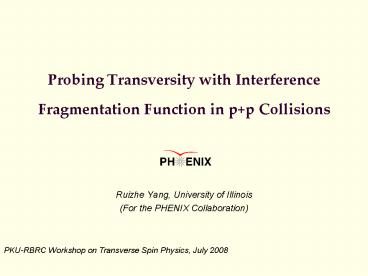Probing Transversity with Interference Fragmentation Function in p p Collisions - PowerPoint PPT Presentation
1 / 23
Title:
Probing Transversity with Interference Fragmentation Function in p p Collisions
Description:
STAR, PHENIX, BRAHMS, 2004~2005. Inclusive AN. HERMES 2005, COMPASS 2006. AUT ... BRAHMS & PP2PP. STAR. AGS pC Polarimeter. Helical Partial Snake. Strong Snake ... – PowerPoint PPT presentation
Number of Views:69
Avg rating:3.0/5.0
Title: Probing Transversity with Interference Fragmentation Function in p p Collisions
1
Probing Transversity with Interference
Fragmentation Function in pp Collisions
- Ruizhe Yang, University of Illinois
- (For the PHENIX Collaboration)
PKU-RBRC Workshop on Transverse Spin Physics,
July 2008
2
Measurements of quark transversity
Underway
1991
2005
Future
pp
RHIC Collins asym.
STAR, PHENIX, BRAHMS, 20042005 Inclusive AN
E704, 1991 Large forward SSA
RHIC IFF asym.
JParc, RHIC, FAIR Drell-Yan
HERMES 2005, COMPASS 2006 AUT
SIDIS
COMPASS p target
JLab 3He and 12 GeV
BELLE 2006 Collins FF
BELLE IFF
ee-
3
Measurement of transversity in pp
Drell-Yan
IFF
Collins
RHIC
RHIC, FAIR
RHIC
4
Comparison of IFF and Collins FF
Interference fragmentation function
J. Collins, S.Heppelmann, G. Ladinsky, Nuclear
Physics B, 420 (1994) 565
Matches PHENIX capability better
J. C. Collins, Nucl. Phys. B396, (1993) 161
5
Definition of Vectors and Angles
Bacchetta and Radici, PRD70, 094032 (2004)
6
Transversity from di-hadron SSA
Physics asymmetry
Hard scattering cross sectionfrom pQCD
Unpolarized quark distribution Known from DIS
IFF Di-hadron FF to be measured in ee-
Transversity to be extracted
7
Why di-hadron SSA in pp
- Di-hadron vs single hadron
- Collinear factorization
- No model uncertainties due to kT dependence of FF
and PDF - Doesnt need quark momentum
- No need to separate effects like Sivers/Collins
effects in single hadron measurement - Completely independent measurement
- Di-hadron measurement in fixed target vs collider
- At higher scale
- sub-leading twist effects suppressed
- factorization assumption better justified
8
Ongoing IFF measurement at BELLE (RBRC/Illinois)
IFF sensitivity projection from data
Artru and Collins, Z. Phys. C69, 277 (1996) Boer,
Jakob, and Radici, PRD67, 094003 (2003)
9
Models for IFF
- Use partial wave analysis of pp phase shift data
to model IFF - Sign change around r mass
- Jaffe, Jin and Tang, PRL 80 (1998) 1166
- Breit-Wigner shape for p wave
- No sign change around r mass
- Trend consistent with HERMES results
- Bacchetta and Radici, Phys. Rev. D 74, 114007
(2006)
10
Polarized pp Collisions at RHIC
- Spin rotators select polarization directions at
collision points - Polarimetry with pC and Hjet
Absolute Polarimeter (H jet)
RHIC pC Polarimeters
BRAHMS PP2PP
PHOBOS
Spin Rotators
STAR
PHENIX
Siberian Snakes
Partial Snake
Polarized H- Source 1 mA 70-80 polarization
Strong Snake
Helical Partial Snake
LINAC
AGS
BOOSTER
AGS pC Polarimeter
200 MeV Polarimeter
The RHIC (Relativistic Heavy Ion Collider)
complex at Brookhaven National Laboratory
11
PHENIX detectors used for IFF analysis
- Use 2 separate spectrometer arms at central
rapidity, h lt 0.35 - Azimuthal coverage 90 90
- Electromagnetic Calorimeters
- PbSC PbGl
- High granularity Dh?Df0.01?0.01
- Tracking of charged particles
- Drift chamber, pad chambers
- Beam-beam counter as a luminosity monitor
- Exploit good event selection capability, high
bandwidth/event rate
12
Event selection
- Data taken in 2006
- Integrated luminosity 2.7 pb-1
- Average polarization 51, in radial direction
- Find charge-ordered pairs (hp0), (p0h-), (hh-)
- p0
- PT gt 1 GeV/c
- h/-
- 1 GeV/c lt PT lt 4.7 GeV/c
- Assuming pion mass for all hadrons
- Both particles come from the same detector arm
(Dh?Df0.7?p/2) - One particle fires the trigger (EMCal cluster
with energy gt 1.4 GeV) - Calculate the asymmetry, extract the analyzing
power
13
vs invariant mass of the pair
Consistent with 0, despite the second bin of p0h-
pairs and the last bin of hh- pairs are 2s from 0
14
vs pT of the pair (0.5 lt m lt 0.78)
Soft physics contributions at at low pT, may be
non-neglegible
15
vs pT of the pair (0.78 lt m lt 1.0)
Soft physics contributions at at low pT, may be
non-neglegible
16
Conclusion and status
- Conclusion
- First measurement of di-hadron SSA in pp
collisions - No significant asymmetries have been observed
with current statistics - New data available from transverse running in
2008 - Integrated luminosity 5.2 pb-1
- Average polarization 46
17
Future
- Prospects from future large transverse spin data
sample from PHENIX - Sub-percent sensitivity possible
18
(No Transcript)
19
PT and Invariant Mass of Pairs
p0h
p0h-
ph-
PT (GeV/c)
PT (GeV/c)
PT (GeV/c)
p0h
p0h-
ph-
mpp (GeV/c2)
mpp (GeV/c2)
mpp (GeV/c2)
20
(No Transcript)
21
(No Transcript)
22
(No Transcript)
23
Particle Reconstruction
- Analyzing data taken in 2006, integrated
luminosity 2.7 pb-1, polarization 55 - Pairs (p0p), (p0p-), (pp-)
- p0
- Photon cluster (energy, shower shape) from EMCal
- di-photon invariant mass spectrum
- PT gt 1 GeV/c
- p/-
- Momentum measured by bent in magnetic field
- 1 GeV/c lt PT lt 4.7 GeV/c
mgg (GeV/c2)
PT (GeV/c)































